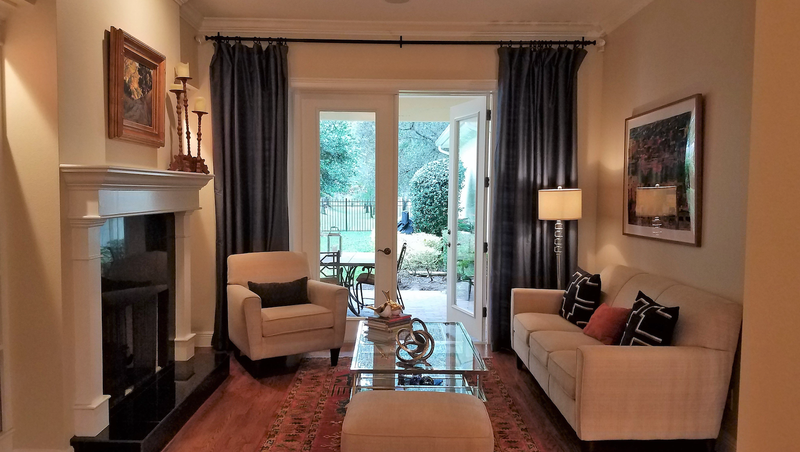"It doesn't have much of a living room," I still remember DC saying, when we looked at the house we ultimately bought and moved into one year ago this weekend.
"Don't let the furniture deceive you," I said, looking past the decor. The 10-by-12-foot room with a fireplace and view of the backyard had all the makings of an inviting living room, you just couldn't tell by the way it was decorated. A long chaise -- seating for exactly one person -- angled dramatically across the space implied there was no room for anyone else. Isolation is not what most people want in a living room.

As a former live-in home stager, I know these three real estate realities: One, decor projects lifestyle; once you declare how a room will be used, most buyers don't see it any other way. Two, an empty house shows better than a poorly furnished one. Three, after curb appeal, the impression a home makes when you first walk in matters more than anything else.
In this house, the living room was the first room you saw. The way it was furnished, which was consistent with the rest of the house, likely explained why the beautiful, structurally sound, Southern plantation style house, with a well-proportioned floor plan, in a beautiful, desirable neighborhood had sat on the market for months.
"It's all here," I said to DC, who was dubious. Fortunately, the needed cosmetic changes, which probably put others off, did not stop us from buying the gem in rough, and for much less than the initial optimistic asking price.
Today, a better-coordinated color palette, a warmer shell, more seating and generally more functional furnishings have created an inviting living room where our friends and family gather to talk by the fire.
Although I've decorated and staged many houses, I don't always know why a room isn't working, I just know that it isn't.
To help me put the transformation into words, I showed the before and after living room photos to Florida interior designer Tina Crossley, who deconstructed the makeover with me, and put the changes I made into concrete advice for anyone redecorating a room:
• Think function first. "When redoing any room, start with the reason," Crossley said. Ask, what do you see happening there? Most people want a living room where they can sit and visit with others. "The room before didn't make any sense. Why furnish a living room for one person?" The seating was disproportionate to the adjacent dining room. The redecorated room seats several. Now when you walk in the front door, you see, oh, here's the dining room where you have a dinner party, and here's where everyone sits afterward.
• Enliven the walls. The original room, as was the rest of the house, had basic builder-white walls. We repainted the living room walls a warmer neutral (Sherwin Williams Patience), which better sets off the white moldings, and added an accent color (SW Quite Coral) to the walls behind the built-ins on each side of the fireplace.
• Ground the floors. The original wood floors were a dated, yellow-blond oak, which contrasted too much with the black granite fireplace, Crossley said. To add richness, we refinished the floors, there and throughout the home, in a mid-tone walnut brown. "The darker color warms up the room and works better with the hearth."
• Dress the windows. We replaced the existing under-scaled drapery and hardware with a heftier rod, fuller drapery panels and more substantial decorative finials. Placing the rods at the ceiling, rather than just over the door, makes the room feel grander, brings the eye up, covers more drywall, and better frames the view, Crossley said.
• Add the right rug. Once you've addressed your shell (walls, floors and windows), start furnishing. An area rug makes a good starting point. Even though the large, animal skin rug in the original living room filled the space," Crossly said, "it wasn't enough to carry the room and didn't look integrated." The current rug's colors (medium and navy blue, deep orange and cream) repeat in the throw pillows, drapery, art, accent walls and upholstered furniture, pulling the room together.
• Accessorize. Although the original room was under-furnished, it was visually quite busy, Crossley said. The three shades of orange -- in the pillows, drapery and artwork -- clashed. And the zebra pillows and other accessories didn't relate. "The overall feel was jarring," said Crossley. In the made-over room, the chrome accent lamp ties to the chrome and glass table. Metallic embellishment on the navy pillows refers to the gold and silver objects on the coffee table, while the lines relate to the geometric pattern in the rug. Color connects the accessories, so the room has flow.
Syndicated columnist Marni Jameson is the author of three home and lifestyle books, including Downsizing the Family Home -- What to Save, What to Let Go (Sterling Publishing).
HomeStyle on 12/01/2018

